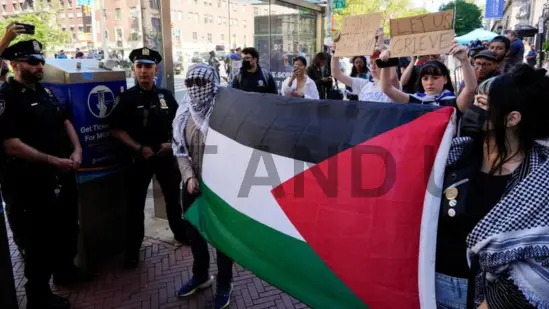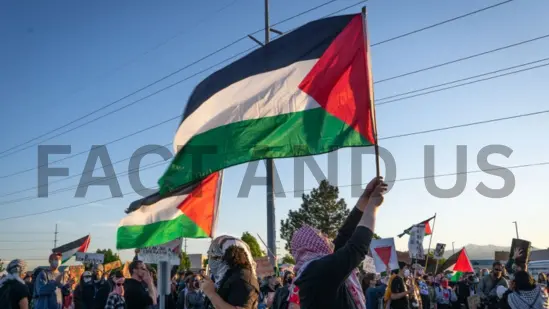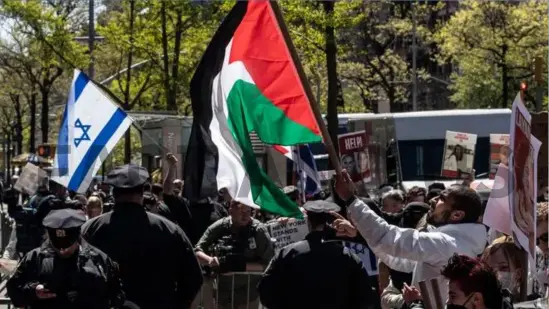Columbia University students started the new term with new protests and increased security just outside the iconic New York City campus. The Ivy League college saw some of the largest and most intense campus demonstrations last term when students protested the Israeli military operation in Gaza. The first day of the term, on Tuesday, all eyes were on the protesters at the school gates to see whether they matched up to the earlier protests.

Columbia University
Police reported at least two arrests on Tuesday but described the gatherings as “peaceful.” Pro-Palestinian protesters—many with their faces covered in traditional keffiyeh scarves—could be heard several blocks away, chanting “Free Palestine” as they banged on drums and marched in circles outside Columbia University’s famous iron gates.
On the other side of metal barricades, students and faculty watched the protest as they stood in line to have their identity carefully inspected before they could be allowed onto campus. Inside, the largest interruption occurred at noon, reports CBS News, the BBC’s partner in the United States. The Alma Mater statue outside the Low Memorial Library was doused with red paint—allegedly by protesters. The area was reportedly cordoned off as a crew worked to clean the statue.


Columbia’s previous academic year ended with the New York Police Department storming a pro-Palestinian sit-in that had occupied the campus quad. Student protesters then took over an academic building, which police eventually cleared after making over 100 arrests.
Columbia University’s new term has started under a shadow of tension. Widespread protests and heightened security measures characterize the campus. This is usually a period of interest and enthusiasm for students and faculty, but the excitement has been overshadowed by demonstrations addressing a range of issues.
Started shortly before the term began officially, the protests, organized by the student groups and faculty members who push a range of causes, from climate actions to social justice movements, have taken their places in the United States in various universities, the heart of Manhattan being one of them. The surge in activity has been witnessed as students and faculty rally for change and voice their concerns over pressing global and local issues.

Among other things, the protests targeted the university’s investment practices. The demonstrators have appealed for the divestment of Columbia from fossil fuels and companies causing environmental degradation. A significant number of the students believe that the university should be more pro-active in countering climate change, speaking to a rising tide of opinion among the youth who feel increasingly threatened by their planet’s future.
Besides the environmental issues, socially just reasons have also been the source of strong protest. There is an appeal for greater diversity and representation within all aspects of the university’s academic and administrative structures. Students have also been vocal about the basic concerns related to campus security and support for the marginalized communities.
The administration responded to this with intensified security measures around the campus. More security personnel, barricades, and increased surveillance had become the normal features on campus. Though these measures were intended to ensure that all members of the university community feel safe, they have contributed to an atmosphere of tension and unease.

University officials have expressed their commitment to maintaining a safe and respectful environment for both protesters and non-protesters. In a statement, President Lee Bollinger emphasized the importance of open dialogue and the university’s dedication to addressing the concerns of its community members. “Columbia University values the right to free expression and is committed to ensuring that all voices are heard in a respectful and constructive manner,” Bollinger said.
Despite these assurances, the tighter security measures have not been controversy-free. Several students and faculty members had drawn concerns that the heightened security measures may “overkill” free expression and create an atmosphere of surveillance. They believe that while safety is paramount, it is equally important to ensure that the university remains a space for open and uninhibited discourse.
Amid all these, the challenge that the university would soon be facing is how to balance security with the need to make a campus where diverse perspectives can exist and be expressed freely. The administration has promised engagement with student leaders and other stakeholders who voice their concerns and subsequently work towards making solutions that would uphold the values of the institution.

The protests and increased security remind one of the fuller, sometimes more contentious campus life at one of America’s top universities. When students return to this New York university for studies, activism and debate continue to fill the air, reflecting issues in communities nationwide affecting schools.
For now, the focus remains on navigating this period of heightened tension while striving to maintain an environment where meaningful dialogue and academic pursuits can continue.
Stay connected with fact and us for more such news.
